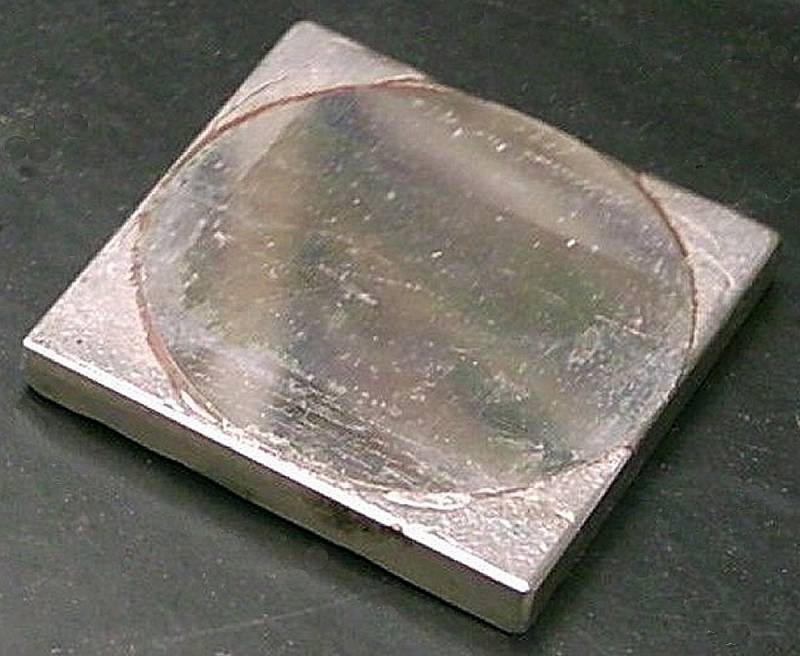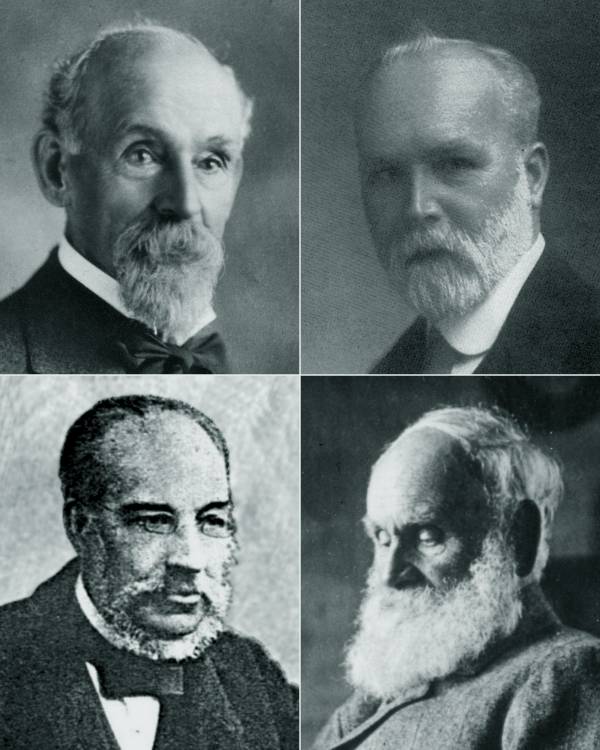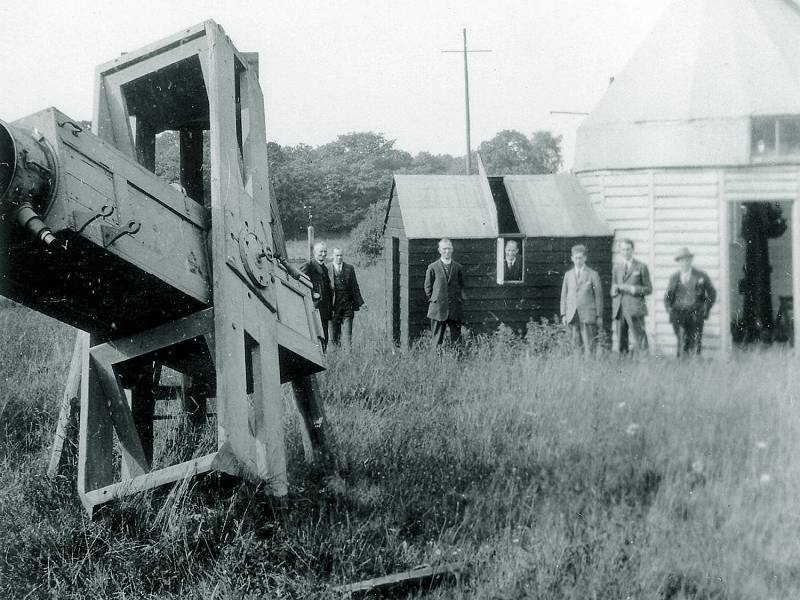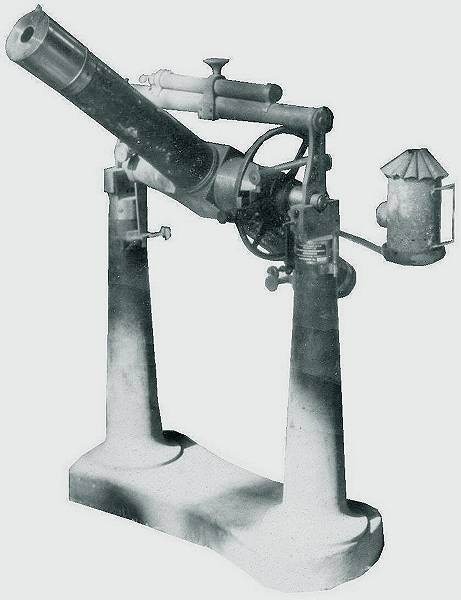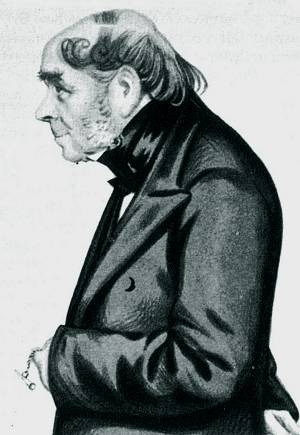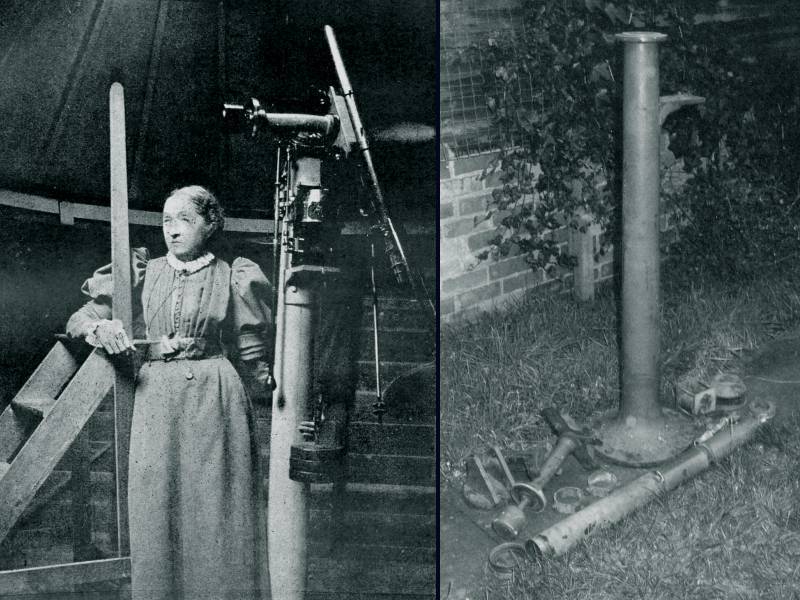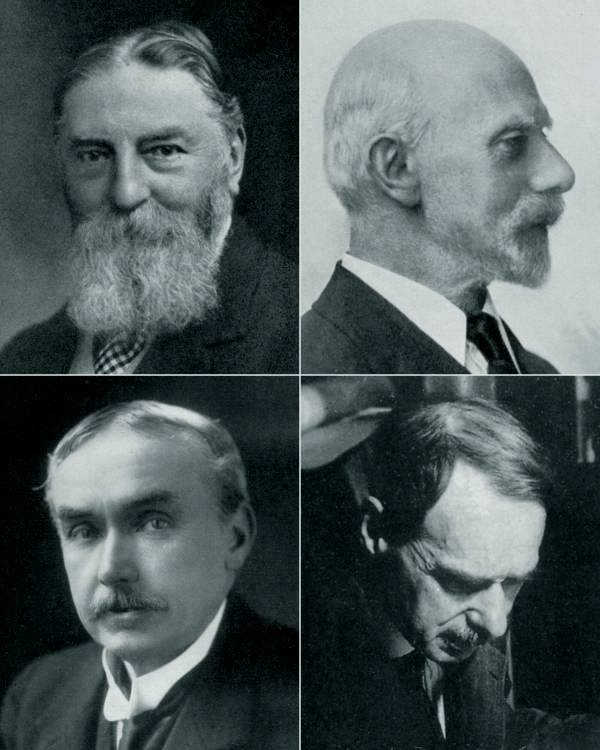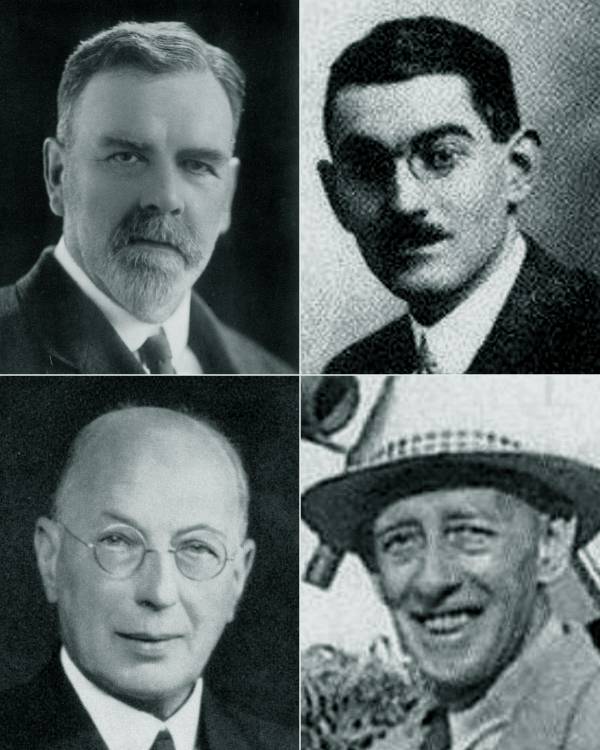|
The BAA
observatories and the origins of the instrument collection R.
A. Marriott Journal of the British Astronomical Association, 117 (6) (December 2007), 309–13 |
|
Within a few months of the
founding of the Association in October 1890 the membership numbered several
hundred amateur and professional astronomers in Britain and around the world.
International recognition was also marked by a number of eminent speakers at
meetings, including the instrument maker John A. Brashear, of Allegheny,
Pennsylvania. In 1888 Brashear had toured the British Isles and Europe,
visiting observatories and meeting many eminent astronomers. He seems to have
been impressed with everyone he met – particularly British amateurs
– and during his second visit to England in 1892 he spoke at the
Association’s meeting on April 27. In December 1890 he presented to the
Association a speculum-metal diffraction grating which had been prepared at
his own works and ruled on Henry Rowland’s engine at Johns Hopkins
University, Baltimore. The proposed observatory In 1895 a second instrument was acquired
when G. E. Niblett placed a 4-inch photographic refractor at the disposal of
members, but there was no direct effort to form an instrument collection,
although thoughts on the subject were occasionally expressed. It was
considered, however, that at some time an observatory should be built and
equipped, and a favourable opportunity arose in March 1897 when the Royal
Botanical Society offered a site at a peppercorn rent in the grounds of its
gardens in Regent’s Park. The offer had first been extended to the
University of London and to the Royal Astronomical Society; but both had
declined, and the Council of the Association immediately decided to secure
what was then considered a prime location. The site was therefore visited by
E. W. Maunder and J. G. Petrie, and subsequent to their report a committee
was appointed to carry out negotiations. The
provision of instruments proved not to be an obstacle, as Nathaniel E. Green
(then President) immediately presented his 18-inch reflector, shortly
afterwards Tyson Crawford (senior partner at Dollond) promised a 2-inch
transit instrument, and George Calver offered to provide an instrument of any
size required (although his offer was not taken up). There then remained only
the problem of funding the observatory building – estimated to be in
the region of £300–400 – which, it was hoped, would be
raised by donations from members. A promising start was made when Elizabeth
Brown donated £50 (the equivalent of 95 years’ subscription), but
no other comparable sums were offered, and over the following few months the
Observatory Fund received only a trickle of guinea and half-guinea
contributions, so that by the end of the year the total stood at £72 5s
6d. (The annual subscription was then half a guinea, the respectable but now
antiquated guinea being £1 1s – £1.05.) At the same time
the Royal Botanical Society was pressing for the scheme to proceed –
although the offer was to be held open for some time – and at the
Association’s meetings various members suggested ways in which the
requisite funds could be obtained. One suggestion was that all 1,100 members
should double their subscriptions for that year – a proposal which, not
surprisingly, met with little response. In
December 1898 the Observatory Fund contained about £145 –
considerably less than half of the amount required – and there were
suggestions that the project should be dropped. However, W. H. Maw (by then
President and at the same time Treasurer) said that Council did not
anticipate any difficulty in obtaining sufficient funds, that the matter had
not been pressed strongly, and that if it were then the deficit could be
raised within three months. But by the following March only another £15
had been received, and no more was heard of the BAA observatory. Opinions
were perhaps represented by a member who in 1902 reclaimed his £10
donation, after which the Observatory Fund simply accrued interest until
1919, when it stood at £194 13s. It was then reduced by depreciation to
£150, and in 1923 £100 was put aside to pay for Variable Star
Section Memoirs whilst the remaining £50 was transferred to the General
Fund. |
|
Instrument no. 1: the diffraction
grating presented by John Brashear in 1890.
(Top) John A. Brashear, E.
Walter Maunder; (bottom) Nathaniel E. Green; George Calver. |
|
Instrument no. 3: 18-inch mirror by
George H. With, presented by N. E. Green in 1897. Here it is set up in a
wooden mount in the rectory glebe of the Rev T. E. R. Phillips at Headley,
Surrey. The photograph was taken around 1930, during one of Phillips’
Annual Visitations. (RAS MS Phillips 5B; © Headley Parish.) |
|
Instrument no. 4: 2-inch transit instrument by Dollond,
presented by Tyson Crawford in 1898. |
|
Bessemer’s observatory In July 1898 – in the midst
of the attempted fund-raising – another opportunity arose, this time to
acquire a complete observatory. Sir Henry Bessemer – who had died
earlier that year – had stated in his will that his observatory should
be placed at the disposal of a public body likely to make use of it. Unlike
the fledgling BAA, Bessemer had considerable funds at his disposal. A
versatile inventor, he had pioneered the large-scale manufacture of steel by
decarburising iron, and by the mid-1860s Bessemer steel was in enormous
demand worldwide, particularly for armaments and for the rapidly developing
railway systems. This made him enormously wealthy, his total royalties, he
claimed, being ‘1,057,748 of the little gold medals issued by Her
Majesty’s Mint.’ In
accordance with Bessemer’s will, his son offered the observatory to the
Association. It stood on Denmark Hill (south of London), on land belonging to
Dulwich College, and commanded a clear all-round horizon except for two or
three distant trees to the north-west. It was equipped with a 40-inch
reflector on an altazimuth mount, with two 6-inch Cooke refractors as
finders. (The original 50-inch mirror was made by Calver in 1884, using a
method devised by Bessemer, but it was not a success and was never mounted.)
The instrument was moved in altitude and azimuth by hydraulic power, the
36-foot diameter dome was connected hydraulically to the moveable floor and
to the azimuth movement, and the observer therefore did not need to change
position, as everything moved together. Attached to the observatory building
was a workshop which could, if necessary, be converted into a
caretaker’s cottage. However, the administration costs were estimated
to be in the region of £300 a year, and although the land was offered
rent-free the lease was due to expire in 1915. The offer therefore had to be
declined. |
|
Sir Henry Bessemer. (Print by Spy.) |
|
The Instrument Fund When at the end of 1898 the
prospect of an observatory seemed to be fading, Harold Whichello suggested
the establishment of an Instrument Loan Fund, which, he said, should be
carried out on thoroughly business lines. He proposed that £1,000 could
be borrowed from the Association’s wealthier members and used to
purchase secondhand instruments. The borrower of each instrument would
deposit half or a third of its value with the Association, and then pay 5% of
the remaining value as an annual fee to prevent instruments being kept when
not in use. This proposal met with no response whatsoever, and it was to be another
ten years before a fund was established, albeit in a different form. In
the meantime, a 3-inch refractor was presented by G. T. Davis in 1898, and in
1899 Elizabeth Brown bequeathed a 3½-inch Wray refractor and its
observatory, a grating spectroscope and an astronomical clock. The following
year a 3½-inch Merz refractor was presented by E. Carr, and Capt
William Noble (the first President) presented a quadrant by J. and E.
Troughton – an instrument made for Sir George Shuckburgh-Evelyn around
1790, and presented to Noble by Shuckburgh’s grand-daughter, Lady
Katherine Harcourt. With eleven instruments in the collection, Council
adopted Regulations for the Loan of Instruments on 27 March 1901.[1] Of these
eleven (see the table), only three – nos. 1, 3 and 6 – remain in
the collection. Even so, no. 1 was untraced in 1968 and recovered in 2004,
and no. 6 was untraced in 1977 and recovered in 1993. No. 3 – the
18-inch With mirror (with a variety of tubes and mounts) – is therefore
the only instrument that has remained unscathed by the rigours of loan, its
most notable users being T. E. R. Phillips (1917–42) and D. G.
Buczysnki (1986–97). |
|
Elizabeth Brown with her 3½-inch Wray refractor,
bequeathed to the Association in 1899 – instrument no. 6 – and
its condition when recovered in 1993. The observatory – instrument no.
7 – was sold in 1905, and the number was later reassigned. |
|
|
|
|
The first eleven instruments |
|
|
|
1 2 3 4 5 6 7 8 9 10 11 |
Diffraction grating by Brashear 4-inch f/8.5 photographic refractor 18-inch reflector, optics by With 2-inch transit instrument by
Dollond 3-inch refractor 3½-inch refractor by Wray Observatory Grating spectroscope Astronomical clock 3½-inch refractor, OG by
Merz Quadrant by J. and E. Troughton |
Presented by J. A. Brashear, 1890 Presented by G. E. Niblett, 1895 Presented by N. E. Green, 1897 Presented by Tyson Crawford, 1898 Presented by G. T. Davis, 1899 Bequeathed by Miss E. Brown, 1899 Bequeathed by Miss E. Brown, 1899 Bequeathed by Miss E. Brown, 1899 Bequeathed by Miss E. Brown, 1899 Presented by E. Carr, 1900 Presented by Capt W. Noble, 1900 |
Untraced, 1968; recovered, 2004 Destroyed during the Blitz, 1941 Still in the collection Sold at Christie's, 1982 Sold at Sotheby's, 1987 Untraced, 1977; recovered, 1993 Sold, 1905 Stolen, 1968 Written off as useless, 1905 Sold at Sotheby's, 1987 Presented to the Science Museum,
1933 |
|
The suggestion for putting aside
funds for the purchase of instruments was raised again in October 1908, when
in his Presidential Address F. W. Levander mentioned that the Association had
no micrometer. (By this time the collection numbered twenty-five
instruments.) At the following meeting the new President, H. P. Hollis,
announced that H. W. Smithers had donated £25 for the purchase of such
an instrument, and it was decided – with Smithers’ consent
– that this sum should form the nucleus of an Instrument Fund. This was
immediately doubled by a donation of £25 from G. J. Newbegin, but no
further contributions were ever received. The money was held in trust without
added interest and remained at £50 until 1934, after which it was
eroded by small amounts spent on repairs to instruments, until the final
£12 10s 9d was secreted into the accounts and the Instrument Fund
closed in 1949 – by which time the collection had grown, by presents or
bequests, to 163 instruments (although 33 of these had already been sold,
given away, lost or destroyed). The only instrument to be purchased during
the Association’s first half-century was an 8½-inch reflector by
Calver (no. 33, in 1918), but this was payed for out of the General Fund. No
micrometer has ever been purchased, although several have been received as
presents or bequests. The Wilfred Hall
bequest In 1952 Dr Wilfred Hall, of Hepple Woodside, Morpeth,
Northumberland, bequeathed a 15-inch Grubb refractor and 15-inch astrographic
telescope, with all fittings and apparatus, including a Hilger stellar
spectrograph, an Evershed solar spectroscope, 5-inch and 6-inch refractors, a
sidereal clock and other equipment, plus a collection of glass lantern
slides. He also directed that the expense of removing the telescope and
re-erecting it – up to £500 – be borne by his estate. This
bequest was no doubt a surprise. Hall had joined the Association in 1913, but
he usually engaged in private research, and very few members knew him. He
was, moreover, of the ‘old school’ – following the
tradition of investing an enormous sum of money in a large observatory and
employing an ‘assistant’ (and often taking the credit for the
observations). However, his bequest indicated that he appreciated the
importance of the work of the Association.[2] |
|
(Top) William H. Maw, Frederick W. Levander;
(bottom) Henry P. Hollis; Philibert J. Melotte. |
|
A condition of
the bequest was that the telescope should not be sold, but should be used
where it could be ‘of service to scientific research.’ It was
evident that acceptance would involve the Association in ‘considerable
moral and financial responsibility’, and Council therefore appointed a
committee to examine the feasibility and possible consequences, while ideas
and suggestions were invited. The affair was considered so important that a
questionnaire was issued to all members. Of the 501 replies received, 318
members said that they would not use the telescope at all, and a further 53
said that they would not use it at Ascot (the proposed most convenient site)
but would use it at Preston or elsewhere. Of the 130 who would use it at
Ascot, only 14 were considered to be ‘serious observers’ –
but seven of them already had telescopes of at least 8 inches aperture, and
the committee considered that anyone with such a telescope would not continue
to travel an appreciable distance, even to use a 15-inch. Those who would
only occasionally use the telescope numbered 74, and 42 members were classed
as beginners, most of whom had never used a telescope. The opinion of those
who said they would not use the telescope was equally divided, for and
against acceptance of the bequest. Council
therefore decided that it was improbable that the telescope would be used
sufficiently regularly, and could not justify spending a substantial part of
the Association’s capital that would be required to provide it with an
observatory, set it up and maintain it. It was also felt that capital would
be better spent in acquiring or constructing a number of smaller telescopes
for loan to members, and another committee was formed – again with
negative results. Consequently,
following the terms of Hall’s bequest the instrument and all of its
equipment passed to the Royal Astronomical Society, after which the Society
placed it on long-term loan to the municipality of Preston (which already
managed the Jeremiah Horrocks Observatory with its 8-inch Cooke refractor).
In November 1957 the Wilfred Hall Observatory, Alston Hall, was officially
opened by the Astronomer Royal, Richard van der Riet Woolley – those in
attendance including Dr Alan Hunter, President of the Association.[3] The
Director of the observatory was Dr Vinicio Barocas, who later served as
President (1970–72). |
||
|
Administration of the
collection After the introduction
of the Regulations in 1901, applications for loan were made to one of the two
Secretaries (occasionally referred to as the ‘Curator’), the
allocation of instruments was decided by Council, and instruments not on loan
were usually placed in the care of an officer or nominated Member of Council.
Eventually, however, it was felt that the administration of the collection
should be centralised, and that advice on instruments and various other
services should be provided. Consequently, in November 1916 a committee was
appointed to take charge of the collection and to deal with all other matters
pertaining to instruments. The Instrument Committee, consisting of P. J.
Melotte (one of the Secretaries), M. A. Ainslie and W. H. Steavenson, was
given ‘power to act, subject to the direction of Council, for the
following purposes: 1. To give advice and assistance, if requested, to
members in the use, maintenance, and adjustment of their own instruments, or
of instruments lent to them by the Association. 2. For the preservation, repair,
and improvement of instruments belonging to the Association. 3. For the use
or loan of such instruments. 4. To consider applications by members, or the
relatives of deceased members, for advice and assistance in the sale, or
disposal, of their instruments. 5. To report to Council cases where the
committee may think it desirable that instruments belonging to the
Association should be sold or otherwise disposed of; or that instruments
should be added to the property of the Association by purchase or otherwise.
6. For the study of improvements and of notable advances in instrumental
theory and practice, and for the publication of reports thereon.’ For
a short time various notes on instruments, and notices concerning
members’ instruments for sale or exchange, were published in the
Journal; but the aims of the Instrument Committee proved too diverse, and in
1917 S. Maxwell (the other Secretary) was nominated Instrument Secretary in
charge of the loan collection, whilst Ainslie was appointed Director of the newly
inaugurated Instruments Section. The following year the name was changed to
Methods of Observation Section to prevent confusion, and since then has been
modified several times [4] – the current incarnation being the
Instruments and Imaging Section. |
|
(Top) Maurice A. Ainslie, William H. Steavenson; (bottom)
Clement O. Bartrum; Frank M. Holborn. |
|
In 1918 the
term ‘Instrument Secretary’ was dropped, and Melotte took charge
of the collection, although he resigned as Secretary in 1921. In 1922 he was
elected a Member of Council, and in the same year a short list of members
with instruments on loan, signed ‘E. Martin, Curator’, was
published in the Journal. Like Melotte, Martin was a member of staff at the
Royal Observatory, Greenwich, but he was not a BAA Member of Council, and the
title ‘Curator’ was unofficial. It appears that Melotte placed
him in charge of the instruments, as following an offer by Sir Frank Dyson
(the Astronomer Royal), those not on loan were being stored at Greenwich (as
was the Association’s large collection of slides, the Curator of
Lantern Slides being H. H. Furner, who also worked at Greenwich). After his
resignation as Secretary in 1921, Melotte served as an elected Member of
Council, and as Acting Secretary 1924–25, until his reappointment as
Secretary in 1926. In 1931 he was succeeded by C. O. Bartrum, who in 1935 was
designated ‘Curator of Instruments’, although this post formed
part of his duties as Secretary and was not included in the published list of
Officers and Council until many years later. Bartrum died in 1939, and was
succeeded as Secretary by F. M. Holborn, who took on the services of J. H. J.
Burtt – a Member of Council – as ‘Deputy Curator’. In
1944 Burtt was designated Curator of Instruments, although he was not a
Member of Council during the 1944–45 session. In 1946 the post became a
separately appointed office, and was thereafter included in the published
list of Officers and Council. The following year the responsibility passed to
K. F. Stonebridge as Acting Curator, and later, Curator. The separately
appointed post of Curator of Instruments has therefore been held by J. H. J.
Burtt (1946–48), K. F. Stonebridge (1948–51), H. Wildey
(1951–76), S. J. Anderson (1977–79) (with the assistance of H. G.
Miles), C. J. Watkis (1979–85), I. G. Ransom (1985–87), A. P.
Dowdell (1987–91) and R. A. Marriott (July 1991–2017). Between
1899 and 1922, lists of the Association’s instruments were occasionally
published in the Journal, but these often comprised only the numbers of the
instruments available or on loan, without descriptions. Between 1922 and 1929
nothing at all was published, after which a list appeared annually until the
late 1970s, although not always with details of availability and excluding
instruments no longer in the collection. The total number of instruments
presented, bequeathed or purchased during the 116 years since the founding of
the Association is 426, of which 181 remain. The current Curator of
Instruments (the author) has compiled, and maintains, a large database
containing the details and loan history of all of these instruments, and
biographical notes on 889 makers, donors and borrowers, including numerous
photographs. The collection, of course, continues to change. |
||
|
Notes and references |
|
|
1 |
J. Brit. Astron. Assoc., 11(6)
254 (1901). |
|
2 |
Details of the bequest, the ensuing procedure and the
final result appear in J. Brit. Astron. Assoc., 62(7) 239 (1952);
62(8) 270 (1952); 63(4) 131 (1953); 63(8) 358 (1953); and 68(2) 48 (1957). |
|
3 |
Soon afterwards, Woolley and Hunter were to become deeply
involved in the establishment of the Anglo-Australian Observatory. The Anglo-Australian
Telescope was produced at Grubb Parsons, the Chief Optician being David
Sinden – a longstanding member of the Association. |
|
4 |
The fortunes of this Section and its successors are
described in History of the British
Astronomical Association – by H. L. Kelly in The First Fifty Years (1948, reprinted 1989) and by E. J. Hysom
in The Second Fifty Years (1990). |

